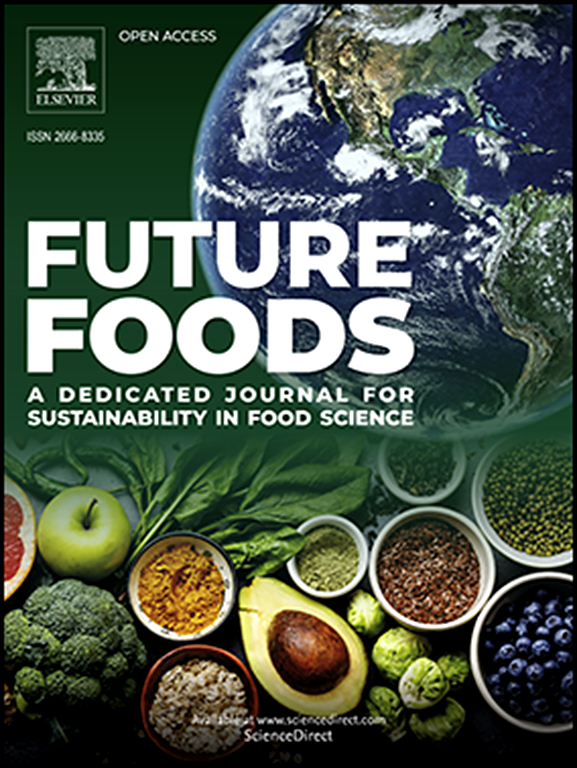Topic: Physicochemical, functional and antioxidant properties of cricket protein powders produced by microwave-assisted spouted bed drying
IF 7.2
Q1 FOOD SCIENCE & TECHNOLOGY
引用次数: 0
Abstract
The study examined the quality of cricket protein powder (CPP) dried using microwave-assisted spouted bed drying (MSBD) and oven drying (OD). Two types of crickets, Acheta domesticus (AD) and Gryllus bimaculatus (GB), were used. Results showed that MSBD produced CPP with higher protein and mineral content and lower fat compared to OD (p < 0.05). MSBD also enhanced functional qualities like solubility, foaming capacity, emulsion ability, water retention capacity, and digestibility. CPP treated with MSBD exhibited significantly increased phenolic content and antioxidant activity (p < 0.05). Cricket species also influenced CPP quality. MSBD-produced protein from AD had a lighter color and superior functional qualities, including solubility, foam stability, and protein digestibility. Conversely, GB-produced MSBD protein showed higher protein and calcium levels, as well as better foam capacity. The faster and more even heating of MSBD, along with its shorter drying time, helps preserve heat-sensitive nutrients and bioactive components. This explains the higher quantities of protein, minerals, phenolics, and antioxidants in MSBD samples. Overall, this study shows that MSBD is a promising way to make high-quality protein ingredient from a sustainable insect protein source that have better antioxidant properties and better functionality.
主题微波辅助喷流床干燥法生产的蟋蟀蛋白粉的理化、功能和抗氧化特性
该研究考察了使用微波辅助喷床干燥(MSBD)和烘箱干燥(OD)干燥的蟋蟀蛋白粉(CPP)的质量。使用了两种蟋蟀,即蟋蟀(Acheta domesticus,AD)和蟋蟀(Gryllus bimaculatus,GB)。结果表明,与 OD 相比,MSBD 生产的 CPP 蛋白质和矿物质含量更高,脂肪含量更低(p < 0.05)。MSBD 还提高了功能品质,如溶解性、发泡能力、乳化能力、保水能力和消化率。用 MSBD 处理过的 CPP 的酚含量和抗氧化活性明显提高(p < 0.05)。蟋蟀种类也会影响 CPP 的质量。用 MSBD 生产的 AD 蛋白质颜色更浅,功能品质(包括可溶性、泡沫稳定性和蛋白质消化率)更优。相反,GB 生产的 MSBD 蛋白质显示出更高的蛋白质和钙含量,以及更好的发泡能力。MSBD 的加热速度更快、更均匀,干燥时间更短,有助于保存对热敏感的营养成分和生物活性成分。这也是 MSBD 样品中蛋白质、矿物质、酚类物质和抗氧化剂含量较高的原因。总之,这项研究表明,MSBD 是利用可持续昆虫蛋白来源制造优质蛋白配料的一种很有前景的方法,它具有更好的抗氧化性和功能性。
本文章由计算机程序翻译,如有差异,请以英文原文为准。
求助全文
约1分钟内获得全文
求助全文
来源期刊

Future Foods
Agricultural and Biological Sciences-Food Science
CiteScore
8.60
自引率
0.00%
发文量
97
审稿时长
15 weeks
期刊介绍:
Future Foods is a specialized journal that is dedicated to tackling the challenges posed by climate change and the need for sustainability in the realm of food production. The journal recognizes the imperative to transform current food manufacturing and consumption practices to meet the dietary needs of a burgeoning global population while simultaneously curbing environmental degradation.
The mission of Future Foods is to disseminate research that aligns with the goal of fostering the development of innovative technologies and alternative food sources to establish more sustainable food systems. The journal is committed to publishing high-quality, peer-reviewed articles that contribute to the advancement of sustainable food practices.
Abstracting and indexing:
Scopus
Directory of Open Access Journals (DOAJ)
Emerging Sources Citation Index (ESCI)
SCImago Journal Rank (SJR)
SNIP
 求助内容:
求助内容: 应助结果提醒方式:
应助结果提醒方式:


